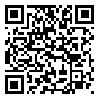Wed, Nov 27, 2024
[Archive]
Volume 12, Issue 3 (September 2015)
IJMSE 2015, 12(3): 66-74 |
Back to browse issues page
Download citation:
BibTeX | RIS | EndNote | Medlars | ProCite | Reference Manager | RefWorks
Send citation to:



BibTeX | RIS | EndNote | Medlars | ProCite | Reference Manager | RefWorks
Send citation to:
Hemmati M H, Vahdati Khaki J, Zabett A. THE EFFECT OF VOLATILE MATTER OF NON-COKING COAL ON THE REDUCTION OF IRON OXIDE AT NON-ISOTHERMAL CONDITION. IJMSE 2015; 12 (3) :66-74
URL: http://ijmse.iust.ac.ir/article-1-831-en.html
URL: http://ijmse.iust.ac.ir/article-1-831-en.html
Abstract: (18477 Views)
The volatile matter of non-coking coal was used for the reduction of hematite in argon atmosphere at nonisothermal condition. A thermal gravimeter furnace enable to use an 80 mm-height crucible was designed for the
experiments to measure the weight changes of about 10 grams samples. A two-layered array of coal and alumina and
four-layered array of iron oxide, alumina, coal and alumina was used for the devolatilization and reduction
experiments, respectively. The net effect of volatile reduction of Fe
2O3was determined and it was observe that 45%
reduction has been achieved. Three distinct regions were recognized on the reduction curve. The reduction of hematite
to magnetite could be completely distinguished from the two other regions on the reduction curve. At 600-950°C, the
reduction was accelerated. 63% of volatile matter resulted in 25% of total reduction before 600°C while the remaining
volatile matter contributed to 75% of the total reduction. From the reduction rate diagram, the stepwise reduction of
the iron oxides could be concluded. The partial overlap of the reduction steps were identified through the XRD studies.
The starting temperature of magnetite and wüstite reduction were determined at about 585°C and at 810°C,
respectively.
Type of Study: Research Paper |
Subject:
forming and mechanical properties
Send email to the article author
| Rights and permissions | |
 |
This work is licensed under a Creative Commons Attribution-NonCommercial 4.0 International License. |






